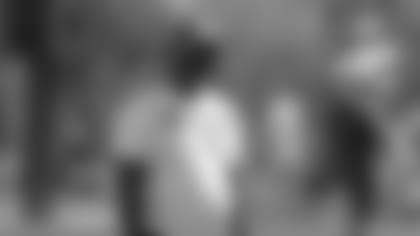GREEN BAY - The 2025 NFL Draft might surpass President Franklin Delano Roosevelt's visit to Green Bay to celebrate its tercentennial as the biggest event in the city's history.
On Aug. 9, 1934, Roosevelt was greeted by roughly 6,000 people, a lively rendition of "Hail to the Chief" by a local band and Battery B's 21-gun salute upon arriving at Green Bay's Chicago & North Western depot; passed an estimated 100,000 people along a parade route over city streets; and spoke to a crowd of about 35,000 at the Bay Beach park pavilion, where he pledged a continuous commitment to his 17-month-old New Deal.
The crowds for the 2025 draft are expected to exceed 200,000; it will unfold in an area around the hallowed grounds of Lambeau Field; and surround the jewel that puts Green Bay on the map like no other similarly sized city, the community-owned Packers. But will that surpass in importance a visit and major address by a sitting president who held the office longer than anyone in our country's history to celebrate Green Bay's 300th birthday?
Let the debate begin.
What is guaranteed is that the pomp and ceremonies of the first-ever draft to be held in Green Bay will transcend by cosmic proportions the one and only NFL Draft up to this point to have taken place in Wisconsin.
The 2025 draft will be the 90th. When Milwaukee was the site of the 1940 draft, held on Dec. 9, 1939, it was the fifth.
Over those interceding decades, the number of passionately interested onlookers has grown exponentially from what was once no more than a handful of people. Furthermore, for almost a decade now, pro football's biggest offseason event has been awarded to different NFL cities based on bids and community support; whereas Milwaukee was the site because it was also the host city for the NFL Championship Game played the next day.
Curly Lambeau and the Packers' executive committee had decided, at the urging of the league, that more money could be made if the game was played at State Fair Park in West Allis rather than at Green Bay's City Stadium.
Starting with the 1937 draft, the second in history, and until World War II, the draft was usually held the day before or after the NFL title game. During the war, the drafts were held in April largely because of the uncertainty over which players would be available come football season. The 1949 draft, held on Dec. 21, 1948, in Philadelphia, was the last to be conducted within days of the league championship.
(FYI: The 2022 National Football League Record & Fact Book listed incorrect dates for the 1938 and '39 drafts. The '38 draft was held on Dec. 11, 1937, not the 12th, the day of the championship. The '39 draft was held Dec. 9, 1938, not Dec. 8.)
Other changes over the years include how the draft is conducted and the atmosphere surrounding it.
The ballrooms of the past where club officials gathered and made their selections have been abandoned, and the picks are now made from draft rooms in the home cities of the 32 NFL teams.
In the process, collegiality has been replaced by a more serious and cut-throat line of attack. The annual Street & Smith's College Football Yearbooks that were once used to gather information on players have been replaced by mounds of reports stored in high-tech computers. The fountain pens and ash trays that were once at arm's reach of those making the picks have been replaced by mouses and nutritious munchies.
The 1940 draft was held in the glitzy but smoke-filled Empire Ballroom of the Schroeder Hotel on Wisconsin Avenue – now the Hilton City Center – and the VIP list of league titans was one that probably hasn't been matched since the start of the stay-at-home drafts in the 1960s.
The Empire's Who's Who list included George Halas, owner and coach of the Chicago Bears; Art Rooney, owner, and Walt Kiesling, coach, of Pittsburgh; Bert Bell, owner and coach of Philadelphia, as well as future NFL commissioner; Tim Mara, founder, and Wellington Mara, secretary, of the New York Giants; George Preston Marshall, president, and Ray Flaherty, coach, of Washington; Charles Bidwill, owner, and Ernie Nevers, coach, of the Chicago Cardinals; Dutch Clark, coach of the Cleveland Rams; and, of course, Lambeau.
All have since been inducted into the Pro Football Hall of Fame.
The draft started at 2 p.m. that Saturday and lasted 20 rounds.
"We'd sit in that damn room, and everybody was suckin' on cigarettes," Lee Joannes, Packers president from 1930-47, told me in 1979 as he recalled in general the years he sat in on the drafts. "You'd get antsy. You were liable to draw anybody. I call that the Stone Age."
While the football people at least might have stayed focused on the task at hand, team owners tended to roam the room making idle conversation.
"I think I used to visit every table in the place while they were drafting," Pittsburgh owner Art Rooney told me in a 1978 interview at his office in Pittsburgh. "They were happy to see some new face. And they knew I didn't pay any attention to the draft. And I wasn't the only one. Everybody would get up and walk around and talk."
While there were 20 rounds, there were only 10 NFL teams at the time and so the 1940 draft moved along faster than it would over the marathon sessions of the near future.
In fact, seven hours after it started, the participants, as well as some of the sportswriters who had covered it, gathered at the nearby Schlitz Brown Bottle for beers and snacks. And in between, they had feasted on tenderloin steaks at a dinner hosted by the Packers.
As for onlookers, the only two might have been Joe Sullivan, a Milwaukee native and future NFL assistant coach and executive, and his older brother, Jack, who was already laying the groundwork for what has since become a cottage industry. There's no way of proving it, but he and Joe might have been the original draftniks. At the time of that draft, Joe was a 15-year-old high school freshman living in Milwaukee.
Given their budding interest in the draft, the Sullivans went down to the Schroeder the night before it started.
"We thought we might be able to talk somebody into getting us in on Saturday," Sullivan told me when I was working on a book titled "Sleepers, Busts & Franchise-Makers: The Behind-the-Scenes Story of the Pro Football Draft," co-authored by Don Langenkamp and published in 1983. "All of them stayed at the hotel. We were too young to go to the bar, but we'd catch them when they'd come out. We were like the mingle-type people. But there weren't many others around. There weren't many people interested in it. And there was no publicity about it."
Rebuffed in their efforts, the Sullivans stayed away the next day but arranged to pick up a list of the picks that evening at the old Milwaukee Sentinel building, located at 123 W. Michigan. They also had gotten a sneak peek the night before of the draft room.
"I had seen the room," said Sullivan. "They only used part of it. It was on the mezzanine above the lobby. There was a bandstand and that's where the league office people were. And there was a dance floor and that's where the tables were set up for each of the teams."
Included in that room was a large board with the names of the top college players eligible for the draft. As he did for other early drafts, Wellington Mara, then 23 years old, compiled the list.
"Your preparation for the draft in those days consisted mainly of people you knew or your coach knew or who formerly played with you and were in college football, and what you could get out of a few football magazines." Mara said in a 1979 interview.
His board was designed to assist the teams that didn't invest much time or money in the draft, but the clubs also were free to pick players not on his board.
"I was interested," Mara said in explaining how he was assigned the task. "I used to spend all my spare time reading magazines and getting out-of-town papers, and so on. And I guess nobody else was willing to make up the list. The reason was I was the youngest one around and they wished it off on me."
The assignment lasted only a few years, according to Mara, before the sharing of information was deemed unnecessary and perhaps too altruistic for competitors like Halas and Lambeau.
With the first choice in the 1940 draft, the Chicago Cardinals selected Tennessee back George Cafego. The Packers selected ninth and took Minnesota back Hal VanEvery.
The Bears landed a windfall, drafting future Pro Football Hall of Fame lineman Bulldog Turner with the seventh overall pick and then two months later trading for future Hall of Fame back George McAfee, who had been taken second overall by the Eagles. The Bears also hit on several other players, including end Ken Kavanaugh, tackles Ed Kolman and Lee Artoe, back Harry Clarke; and the sleeper of the draft, back Ray "Scooter" McLean out of St. Anselm College in New Hampshire, with their second-to-last pick.














